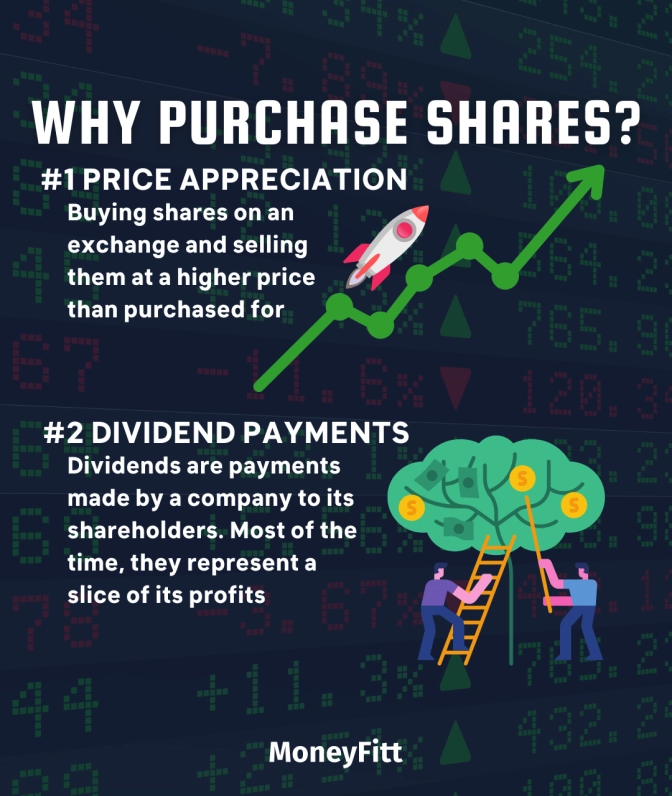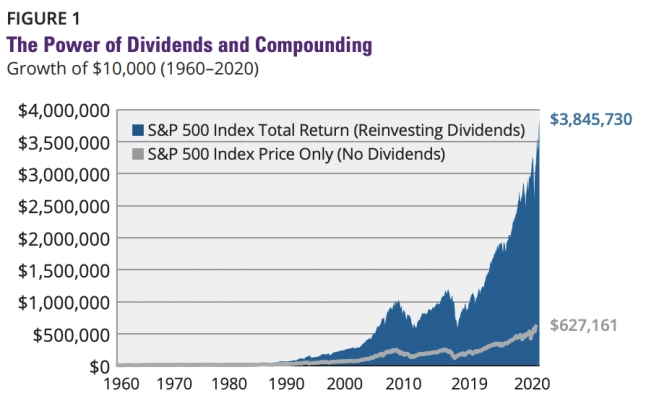Benefits of Shareholdership & Categorising Shares in the Stock Market
There’s more to it than price appreciation!
- Shares can benefit in two main ways, price appreciation or dividend payments.
- Other benefits include a claim on the company’s assets in the case of bankruptcy and liquidation and voting rights in the company, meaning that you can influence the company's running.
- Shares do come with risk. The worst-case scenario for any shareholder is losing 100% of the amount invested (it can only be more than 100% if you have borrowed money to get those shares).
Why Do Investors Purchase Shares?
Purchasing shares makes you a shareholder of the company. As a shareholder, you can benefit from a company’s success in two main ways:

#1 Through an Increase in the Share Price
This method involves buying shares on an exchange, for example, the New York Stock Exchange, and selling them at a higher price than purchased. For example, if you buy 10 shares at $20 each, and then sell them for $30 each, you will have made a profit of $100 (assuming no tax or other costs). Of course, you don't have to sell the shares to have increased your wealth by the amount the shares have gone up by.
Factors that may impact a company’s share price (on a stock market):
- Supply and demand
- Economic conditions (e.g. inflationary outlook, currency moves)
- Sector and company-specific conditions (e.g. a change in growth prospects, expected mergers and acquisitions, the stability of dividends, disruptive or collapsing competition or raw material price changes)
#2 By Receiving Ongoing (And Possibly Increasing) Dividend Payments
Dividends are payments made by a company to its shareholders. Most of the time, they represent a slice of its profits. Whether a company chooses to use their profits to pay out dividends or not is generally up to the management, meaning that not all companies pay dividends. In addition, those who pay dividends do not all pay at the same rate.
Successful companies can see their dividend payouts gradually increasing over time as they become more profitable. For example, Coca-Cola, a well-known consumer brand, has increased its dividend payout for the past 59 years.
Investors sometimes overlook dividend investing, unaware of how powerful it can be in the long run. Let’s demonstrate with an example of the growth of $10,000 when invested in the S&P 500 with reinvesting dividends:

However, it is essential to note that both share prices and dividend payouts can also decline. In addition, past performance is not a determinant of future performance.
Other benefits:
As a shareholder, you have a claim on the company’s assets in the (rather extreme) case of bankruptcy and liquidation. However, you’d rank behind all creditors (i.e. people or companies who the company owes or has borrowed from, including the company's bondholders) before receiving any assets.
As an ordinary shareholder, you can enjoy voting rights in the company in proportion to your ownership, which means that you can influence the company's running.
What’s the Biggest Risk With Investing in Shares?
The worst-case scenario for any shareholder is losing 100% of the amount invested. This is limited to the total amount you invested in that company and no more. The company's creditors can't come after you and grab your other assets even if you are a shareholder of that company! That's what the word "Limited" in a company's name refers to.
If you happen to have borrowed money to buy those shares, you actually could lose more than what you put in as you would still have to pay back that loan.
Categorising Shares
Market participants often categorise shares based on their characteristics, such as:
- Blue chips (large companies with solid and long track records)
- Growth shares (anticipated above-average growth)
- Income shares (companies that pay high and/or stable dividends relative to the share price)
- Cyclical shares (prospects greatly affected by macroeconomic developments and business cycles)
Shares are also commonly grouped by:
- Sectors (e.g. Tech, banks, healthcare, retail, energy)
- Size (e.g. Large-cap, mid-cap, small-cap, all share)
- Geography (e.g. European, USA, Chinese)
- Or any combination of the above (e.g. Large-cap European healthcare or small-cap ASEAN banks)
You Don’t Have to Purchase Shares Local to You!
Many investors diversify their stock portfolios by investing in successful overseas companies such as Apple, Unilever, Amazon, Toyota and Microsoft.
From a defensive point of view, if an unfavourable economic or geopolitical event were to occur specific to your local destination, your portfolio would be at less risk if it were also to include overseas shares.
From an ambitious point of view, having international shares could allow exposure to more successful companies and markets worldwide. For example, suppose you were local to Singapore and believe that there is a good opportunity to invest in renewable energy in Europe. In that case, the SGX does not list companies such as Vestas, so you shop abroad.
When investing in overseas shares, do as much or even more due diligence than you would for your local shares, as you are unlikely to have ‘local knowledge’ everywhere! Understand currency risks, foreign transaction and custody costs and the tax implications before purchasing any international shares.
Most local brokers will have trading capabilities in the US and selected overseas markets but require additional information. If you're uncomfortable with picking overseas shares, or trading hours in a different time zone, then purchasing unit trusts and ETFs are sensible options.
WHY PURCHASE SHARES? COMPLETED. ✅
Sources:
